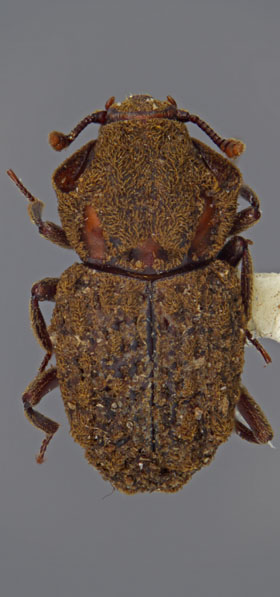 |
 Previous Genus Next Genus Previous Genus Next Genus 
Genus: Usechimorpha
Diagnostic Features
- Description: Antennae 11-segmented with a 3-segmented club. Antennal setation sparse. Subantennal grooves absent. Eyes well-developed, elongate-oval, somewhat reniform, coarsely faceted, extending well onto dorsal portion of head. Submentum in male with a setose pit. Pronotum with anterolateral antennal cavities/grooves located above lateral margin, clearly visible from above. Pronotum narrowed anteriorly, distinctly margined laterally. Pronotal disc distinctly setose. Procoxal cavities open. Metacoxae widely separated, separation as wide as metacoxal length. Abdominal ventrite 5 with a thin preapical groove. Tarsal formula 5-5-4. Dorsal surface with patches of short, thick, pale setae. Dorsal and ventral surfaces commonly encrusted with dirt and debris.
- Similar genera: The genus Usechimorpha is similar to the genus Usechus. Usechimorpha can be readily distinguished by the more abrupt and compact antennal club, open procoxal cavities, truncate apex of the prosternal process, and the posterolateral depressions of pronotum connected by a transverse groove at the base. In Usechus, the antennal club is less compact, the procoxal cavities are closed, the apex of the prosternal process is distinctly widened, and the posterolateral depressions of pronotum are not connected by a transverse groove at base.
Known Distribution
- Northwest (OR), Southwest (CA) USA, Vancouver Island, British Columbia (Canada).
Biology
- Usechimorpha has been collected sifting leaf litter and detritus in conifer forests and from decaying fruiting bodies of Laetiporus sulphureus (Polyporaceae).
Abundance: Moderately rare.
North American Species (2)
North American Species (2)
- Usechimorpha barberi: Clypeus densely setose. Elytra with a number of setose tubercles. Elytral setae distributed throughout, but more dense on elytral tubercles. Distribution: California, Oregon, USA; British Columbia, Canada.
- Usechimorpha montanus: Clypeus sparsely setose or glabrous. Elytral intervals 1, 2, and 4 regular, not carinate. Elytral setae more or less evenly distributed. Distribution: California, USA.
Potential Problems with Identification
- Members of this genus are frequently encrusted with dirt and other debris which may conceal the diagnostic characters.
Selected References
|
 |
 
Usechimorpha barberi
© N.P. Lord |
© 2011-2015 Lord, N.P., Nearns, E.H., and K.B. Miller
The University of New Mexico and Center for Plant Health Science and Technology, USDA, APHIS, PPQ.
|


